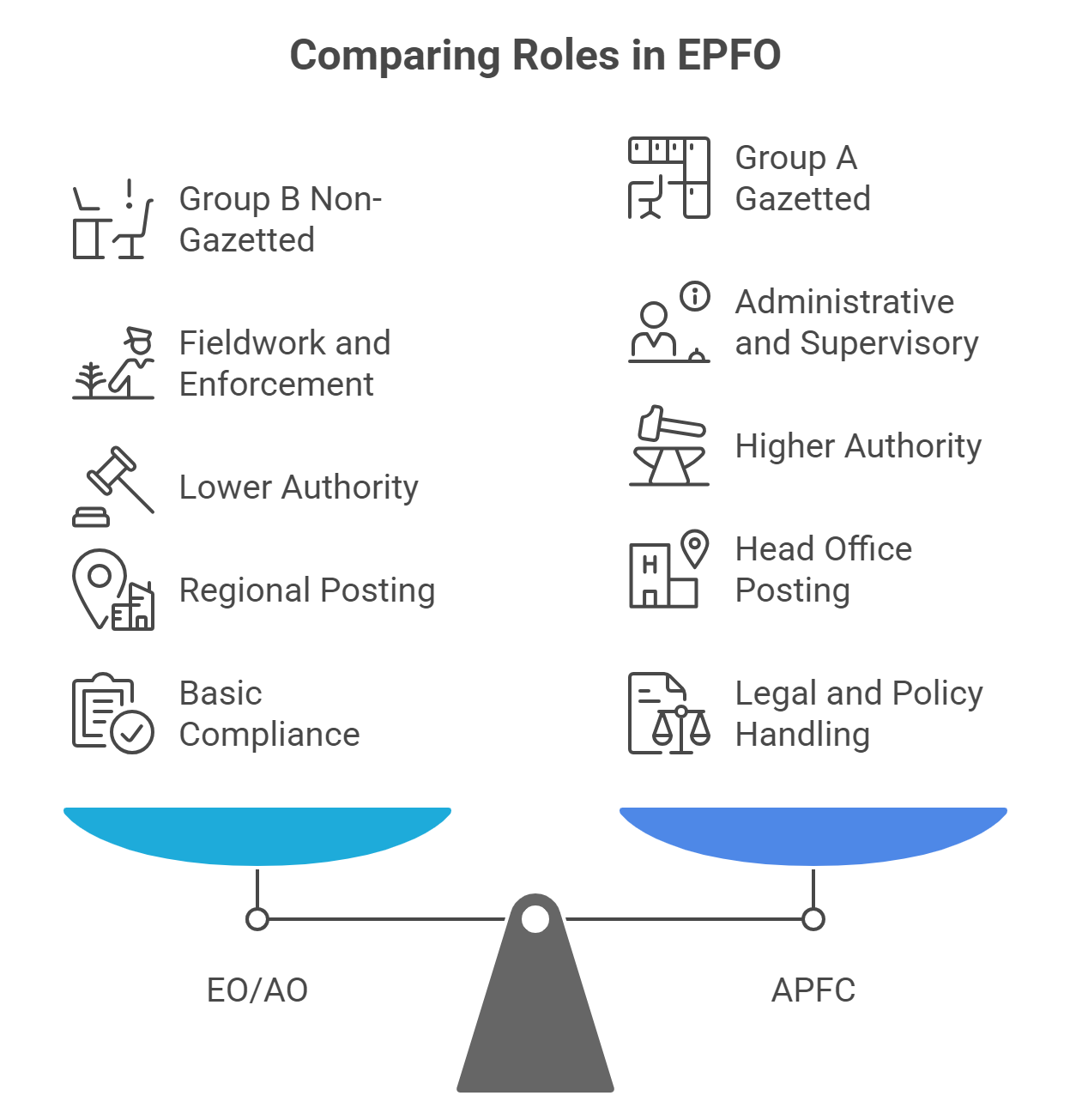The Employees’ Provident Fund Organisation (EPFO) conducts recruitment drives through UPSC for two distinct positions: Enforcement Officer/ Accounts Officer (EO/ AO) and Assistant Provident Fund Commissioner (APFC). Though both roles are part of the same organization and work towards managing social security functions under the Ministry of Labour and Employment, there are key differences in their responsibilities, authority level, and job functions. Understanding these differences is crucial for aspirants preparing for either of these exams, as the nature of duties and career progression in both roles differ significantly.
Difference Between EO/AO and APFC
While both EO/AO and APFC roles fall under the umbrella of UPSC EPFO Recruitment 2025, they differ significantly in terms of responsibility, authority, and job nature. EO/AO is more of an enforcement and field role that deals with day-to-day compliance, whereas APFC is a managerial and policy-driven post involving supervision and administration. Aspirants should evaluate these differences carefully before choosing which post aligns with their career goals, work preferences, and long-term aspirations.
EO/AO Role and Responsibilities
The Enforcement Officer/Accounts Officer (EO/AO), with 154 vacancies in 2025, primarily works at the ground level, ensuring that establishments are complying with EPFO regulations.
- Conducts inspections of factories and establishments to ensure compliance with the EPF & MP Act, 1952.
- Monitors timely EPF contributions from employers and identifies cases of non-payment or irregularities.
- Handles grievances of EPF subscribers related to accounts, claims, and contributions.
- Issues notices to defaulters and initiates action against non-compliant organizations.
- Maintains accounts and records related to employee provident fund contributions.
- Assists in recovery proceedings to collect dues from defaulting establishments.
- May be required to visit field offices regularly and conduct surprise compliance checks.
- Engages directly with both employers and employees to enforce statutory obligations.
- The role is primarily field-oriented and enforcement-based.
- Classified as a Group B Non-Gazetted post with operational authority at the ground level.
APFC Role and Responsibilities
The Assistant Provident Fund Commissioner (APFC), on the other hand, holds a more administrative and supervisory role.
- Holds the position of a Group A Gazetted Officer within EPFO.
- Supervises multiple EO/AOs and ensures proper functioning of regional/zonal offices.
- Responsible for the implementation of EPFO schemes and policies across assigned regions.
- Handles policy execution, inter-department coordination, and financial planning.
- Makes high-level administrative decisions related to EPF operations.
- Looks after legal matters under the EPF Act and may represent EPFO in courts or tribunals.
- Manages large volumes of organisational and financial data.
- Coordinates audits, internal inspections, and compliance reviews.
- Ensures smooth operation of all field offices under their jurisdiction.
- Primarily an office-based role, focused on administration and strategic decision-making.
Key Differences Between EPFO EO/AO and APFC
While both EO/AO and APFC officers contribute to the same organisational mission, there are several differences in their nature of work:

Position Level: EO/AO is a Group B Non-Gazetted post, whereas APFC is a Group A Gazetted post.
Type of Duties: EO/AOs are mainly responsible for fieldwork and enforcement, while APFCs perform administrative and supervisory functions.
Authority: APFCs have a higher rank and may issue directives to EO/AOs. They are involved in decision-making processes and policy execution.
Posting: EO/AOs are posted in regional or sub-regional offices and are often in the field. APFCs are more likely to work from regional or head offices.
Legal and Policy Work: While EO/AOs deal with compliance on a basic level, APFCs handle court cases, legal interpretations, and inter-department communication.
| Related Posts | |
| UPSC EPFO APFC EO/AO Syllabus | UPSC EPFO APFC Syllabus |
| UPSC EPFO Eligibility 2025 | UPSC EPFO Salary |
| UPSC EPFO APFC Salary | |




 UPSC EPFO Result 2025 Out For EO/AO &...
UPSC EPFO Result 2025 Out For EO/AO &...
 IOCL Non Executive Personnel Recruitment...
IOCL Non Executive Personnel Recruitment...
 Bank of India Credit Officer Recruitment...
Bank of India Credit Officer Recruitment...







